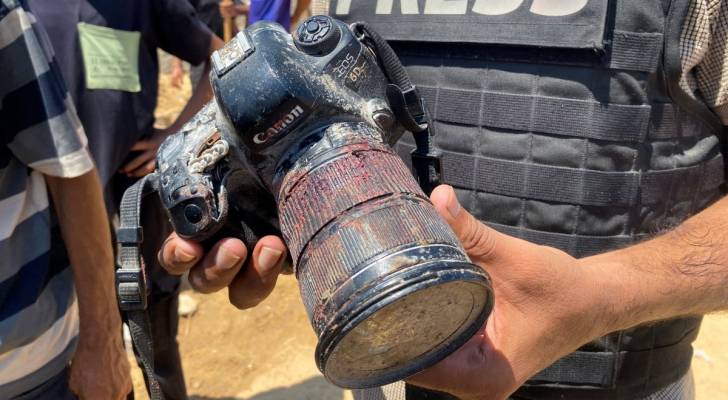The blood-covered camera belonging to Palestinian photojournalist Mariam Abu Dagga (Credit: AFP)
NYT refutes 'Israel’s' explanation for deadly attack on first responders, journalists
A New York Times investigation has cast serious doubt on 'Israel’s' justification for the airstrikes that devastated Nasser Hospital in Khan Younis last week, killing at least 20 Palestinians.
In a video analysis released Sunday, the newspaper stated, “An analysis of video evidence and footage from the scene raises questions about what they [Israel] were targeting to begin with and why they launched a second attack that killed first responders and more journalists.”
The strikes five journalists who were covering the aftermath of the initial bombing. Medics and first responders were also among the victims.
Read more: VIDEO: At least five journalists killed in 'Israeli' strike on Nasser Medical Complex
The Times’ review of available footage found that 'Israel' struck two separate spots at the hospital, including an outdoor staircase regularly used by journalists from Reuters and the Associated Press (AP) to livestream events in Khan Younis.
'Israel' later claimed its Golani Brigade had aimed at a "Hamas-operated" camera, though it presented no evidence. Moreover, the NYT noted that the explanation failed to account for the second strike, which took place 15 minutes later.
The only camera visible in the video evidence belonged to Reuters cameraman Hussam Al-Masri, the investigation said. It added that no Hamas surveillance camera could be seen at the site.
Footage reviewed by the Times showed rescue teams and journalists wearing safety vests rushing to the stairwell. Among them were AP reporter Mariam Abu Daqqa and Reuters photographer Hatem Khaled, whose camera captured what the NYT described as a “chaotic rescue operation on the stairway with no sign of a military threat.”
Just nine minutes after the first blast, 'Israel' launched what appeared to be a “double-tap” strike, two rapid projectiles targeting the same area. Such attacks are known tactics used by militaries to hit not only initial victims but also rescuers and journalists who arrive immediately afterward. The tactic has drawn widespread condemnation when used by Russia in Ukraine.
Prime Minister Benjamin Netanyahu later referred to the incident as a “tragic mishap” but offered no details about accountability measures for the brigade involved, nor any outreach to the Palestinian families of the dead.
Read more: "Israel deeply regrets the tragic mishap," Netanyahu on bombing Nasser Hospital
Meanwhile, Channel 14, a pro-government 'Israeli' outlet, quoted military sources alleging the strike had killed “terrorists disguised as journalists” and that Nasser Hospital was being used as a Hamas command post.
The outlet further claimed, “According to the current security concept, any place where terrorists operate, whether it used to be a school or a hospital, becomes a legitimate target.”
International law, however, explicitly protects hospitals and journalists from military attacks. Exceptions exist only in rare cases where proof of hostile use is overwhelming, a threshold critics argue 'Israel' has failed to meet.
On Monday, the International Association of Genocide Scholars declared that 'Israel’s' military campaign in Gaza meets the legal definition of genocide, intensifying global scrutiny of attacks like the one at Nasser Hospital.




